#it tends to be more of a class divide than a regional divide which is rly interesting
Explore tagged Tumblr posts
Text
i swear they have the same australian lady do the ad reads for every uni podcast ad and i will be so real i hate her shut uppppp
#its a very clean corporate australian accent that puts me on edge#i cannot stand that variant of australian accent it’s like they have to sound australian enough to be One Of Us but clean and legible for#foreign listeners to understand#it’s hard to explain really because australia doesn’t have so many regional accents or like. they aren’t too noticeable#(except adelaide idk how they managed that)#it tends to be more of a class divide than a regional divide which is rly interesting#like there is very much a posh australian accent#and the ocker accent is kind of what other countries seem to think we sound like#but most people are in the middle#i would love to know if australians are slowly sounding more american considering their dominance in pop culture#having many thoughts today and none of them are about the assignment i need to do
2 notes
·
View notes
Text
Lore: Baldur's Gate #2
Demographics of the Western Heartlands
Link: Disclaimer regarding D&D "canon" & Index [tldr: D&D lore is a giant conflicting mess. Larian's lore is also a conflicting mess. There's a lot of lore; I don't know everything. You learn to take what you want and leave the rest]
The City | Demographics | Law & Legal System | Administration & Government | ??? - WIP
A sort of overview of how people fit into the region. When I say "Baldur's Gate is a human city" I am not overexaggerating.
So: detailing the five main human groups of the region: the elves would rather stay in Evereska, thanks; the half-elves would rather not stay in Evereska: the halflings are cheerfully exploiting the local adventurers; the gnomes mind their own business; the dwarves have a local history that's just the world hitting them with sticks; and for some reason the Hells have it out for the Western Heartlands, and tieflings are resented for being a reminder. (And the occasional half-orc and dragonborn is there too, I guess.)
-
While the exact percentages may have shifted up or down somewhat over the course of events at the end of the Era of Upheaval and so on, they're still a pretty solid idea of what to expect from the Western Heartlands, and thus Baldur's Gate as the largest population centre (it's also where the most diversity is, being the only major port city for miles).
The breakdown is:
78% Human 7% Elven 4% Half-elven 3% Halfling 2% Gnome 1% Dwarf 1% "Other" [Tiefling, Half-orc, Dragonborn]
-
So 78% of the entire population of the Western Heartlands is human; consisting mostly of five ethnic groups. These groups being defined by their shared inherited cultural norms and genetics across Faerûn. Chondathan culture heavily shapes Baldur's Gate.
80% of these humans are Tethyrian [melting pot of cultures and genetics, predominantly Calishite and Chondathan by ancestry. By average: brown skin; black hair; blue eyes (northern) or brown eyes (southern). Their primary ancestors were the native people of the lands that became Tethyr and Calmishan. The further north you go the more Netherese and Illuskan genes enter the pool, and lighter skin and blue eyes becomes more common. In the Western Heartlands - they mostly follow Chondathan cultural norms. They have a history of being colonised and enslaved (largely by Calimshan), value freedom and community above all else; slavery is the pinnacle of evil. They have a strong bardic tradition due to relying on oral lore and song to keep their histories and what remains of their distinct culture alive (the majority of their cultural norms will be determined by the dominant culture they've mixed with). The average Tethyrian is raised to mistrust authorities with more jurisdiction than a city state (kingdoms and empires = bad). -
10% are Calishite [dark brown skin; black hair; dark brown eyes. Tend to be short. Due to genie ancestry, most genasi are Calishite]. The percentage is probably higher in the 15th century, due to a wave of refugees. The ancestors of the Calishites were slaves of genies who came to Toril, set up their empires, annoyed the local elves and got wiped off the map and left the humans to inherit their master's empire. Calimshan is one of the oldest human empires still standing, and they're very proud of this fact. They value reputation above all else (personal and family, both highly interconnected) which is basically a form of social currency. Very strict social divides: Class matters, traditionally they're patriarchal and gender roles are strict, marriage is important and the father determines social class (only women may marry "above their station"). In recent history, a return of the ruling djinn and efreeti led to a lot of war and destruction in Calimshan, sending a wave of refugees into the world. Most of those refugees live seperate from the main city in "Little Calimshan" in the Outer City. Said war has recently ended, due to the actions of a Chosen of Ilmater, and many Calishites in Baldur's Gate are considering returning home (especially because there is considerable friction between the refugees and the locals). Sorcery is a common occurance, and Calishites have a strong arcane and divine tradition. -
5% are Chondathan ["tawny" brown skin; light brown to black hair; brown or green eyes. Tend to be tall]. Their ancestors started off as warriors, whose many wars led to them destroying an elven city and a retaliatory tidal wave that eventually led them to discover that trade worked better for them (this did not stop them pissing off elves everywhere they went), they did such a good job that they dominated Central Faerûn through mercentile skill, and Chondathan culture (i.e. language, the Thorass alphabet and such) is a major influence pretty much all over Faerûn. Typically Chondathans have adapted quickly and peaceful to the norms and laws of other peoples, and a Baldurian, Cormyrian and a Sembian will not be perfectly interchangable. Still they will often have shared values: Violence is tacky and counterproductive. a reputation for honesty is paramount and breaking your word is taboo. Tend to be cat people, with a strong appreciation for tressyms. They value hard work, industry and admire wealth (which is power and evidence of a good work ethic). Social standing is determined by money and influence. Class divides don't tend to be rigid, and it's generally believed that hard work should open doors. You start work at 12 (apprenticeships) and if you're able bodied you will be shamed for "not pulling your weight". The elderly tend to hang around after retirement and tutor the next generation. They have little in the way of magical traditions, or interest in it. -
3% are Illuskan [pale skin; blonde, red or black hair; blue or grey eyes. Tend to be very tall]. Rarely found outside of the North (including the Sword Coast North, across the border), most Illuskan cultures are tribes and settlements on the frontiers. They value courage, battle prowess and survival and haven't been as successful in the larger world because they tend to prefer war and raids to trade. Larger civilisation hinders growth and encourages weakness and dependency, and is largely shunned. The rest of the world considers them "no better than orcs" and the Illuskans think the rest of the world are a bunch of cowards unworthy of respect. Not being able to be the warrior hero of some kind of epic tale (or being bold enough to aspire to be) is not necessarily a thing to be ashamed of that you will be mistreated for, but you won't be given any respect past basic courtesy either. Magic is not infrequent amongst Illuskans, due to Netherese ancestry, but it is mistrusted due to the history of the Arcane Brotherhood of Luskan, who are evil bastards. Religion is eh. Illuskans generally only have uses for gods who serve a practical purpose (so appeasing the gods of fury (such as Auril and Umberlee) and Tempus, god of war). -
1% consists of the Gur [brown skin; thick, straight black hair; dark brown eyes. Tend to be hirsute and short, but "stocky"] The ancestors of the Gur were Rashemi, a people they still strongly resemble, physically. The modern people feel no kinship with their distant kin though. They're mostly nomads, but some Gur can be found permanently settled in the slums of cities like Baldur's Gate and Elturel, where they're treated as subhuman. Their patron deity is Selûne: protector of travellers and outcasts, and a patron of diviners, which the Gur practice for protection and aid in navigation (as such they also worship Savras, god of truth and fate, patron god of divination). Amongst their own the Gur speak a unique dialect of Rashemi that no outsiders are privy to. There's not a lot on the Gur, but if they share any cultural norms with the Rashemi, it might be something like this: The Rashemi value personal skill/strength (in whatever form that takes) and achievements, and scorn the concept of inherited (unearned) titles and wealth. They also value the wellbeing of the land itself, to which they show respect. While they don't shun work, they don't live for it either; the youth are often found carousing loudly with their friends, and while the adults are expected to contribute to society, they also enjoy a good time. Children are subject to tests as they mature, and elders are afforded great respect for their experience and the challenges they have overcome in reaching their age. Interestingly, Rashemi expats also have a reputation for being "nuisances" outside of Rashemen: many struggle with culture shock, and the stereotype is that they will get drunk and wander around picking fights everywhere (the Rashemar norm of challenging others to help them and you improve comes across as aggression to outsiders). -
The remaining 1% is a mixture of the many, many, many different humans on Toril. This canonically includes one of Faerûn's only Maztican communities, consisting of the Nexala people living in Baldur's Gate (I think they drew inspiration from the Mexica?) and there appears to include a Kozakuran (Japanese fantasy counterpart) minority. TSR's decision to start creating fantasy world counterparts to real world cultures for "exotic" expansions is... hmm, contentious, and I don't know enough about the real world counterparts to know if I'm handling it well, so I'm not going further into that.
------
7% of the population of the Western Heartlands is elves, making up the largest non-human population of the region.
It's mostly moon elves [fair skin, often seen in literal white hues likened to alabaster and marble, with blue undertones; white, silver (like the metal, not grey) or black hair; eyes always flecked with gold] and then some wood elves [copper brown skin, tinged with green; blonde, red, brown or black hair; brown or green eyes. Metallic sheen to hair and skin.] Some sun elves returned to Faerûn in the mid-1300s [gold, bronze or amber skin; blonde, red or black hair; golden brown, green or black eyes. Metallic sheen to hair and skin.] (both moon elves and sun elves are categorised as "high elves", in BG3 mechanical parlance). Moon elves are individualistic and have a reputation for flightiness, thrill-seeking and hedonism. Sun elves are conservative, more observant of social hierarchies, have a strong cultural focus on magic (divine and arcane both) and extremely wary of humans due to historical conflict and human expansion into (now lost) elven lands. Wood elves are known for their open mindedness towards non-elves and many hope for elves to live fully amongst the non-elves one day, but due to their nature-oriented spirituality and way of life they rarely venture into human civilisation and are usually highly uncomfortable there. When compared to the percentages of other demihumans in the area, the elven population seems very high, though that 7% accounts for Evereska, the last major bastion of elven civilisation on Faerûn. Although apparently the elves are trying to rebuild Myth Drannor yet again, and good luck with making that stick. While elves do make up the largest non-human minority group in Baldur's Gate, the vast majority of that 7% traditionally remains in Evereska and refuses to leave their homeland's borders, and of those that leave it's almost entirely moon elves, who are the most likely to assimilate into human culture. A minority of wood elves might be able to get comfortable in cities. Your average sun elf, to whom preservation of elven culture is a sacred duty given by Corellon him/herself, would be horrified by the concept of assimilating into the N'Quess, and any that aren't are going to be under immense social pressure from their house/clan to come home and conform (especially because there's a chance that their family may view humans as dangerous). That said, the flightiness of youth can generally be forgiven (they'll grow out of it). Most encountered are young adventurers under 100 years old and semi-nomadic family groups of moon elves who wander between human settlements as their whims (and/or the mercantile work of their clan/house) takes them. Older elves are unlikely to be found in Baldur's Gate in high numbers, as the rapid, demanding pace of the metropolis clashes badly with the "take your time" philosophies and lifespan of elves. A few families of sun elves also established themselves in the minor human cities of Iriaebor and Berdusk, further South East, after returning from the Retreat.
- 4% of the population is half-elven, almost entirely of moon elven descent, and, on the human side, likely to be of Tethyrian ancestry.
It's likely most are found in human cities, even if they weren't already born there. The noble houses of Evereska have traditionally been extremely xenophobic (even the elven commoner clans were considered beneath them), and the only non-elves permitted entry for most of Evereska's existence have been Harpers: the opportunities for half-elves to be born within the realm have been fewer that otherwise. Human civilisations also saw an influx of half-elven immigration during the late 14th century - albeit most moved North - when the Spellplague caused Evereska and the Feywild to merge slightly, and an increase in xenophobic attitudes made many feel unwelcome.
- 3% is halfling, almost entirely lightfoot [very, very wide genetic pool. The hin have moved around enough that no features or colouration has become a norm for an entire geographic population.]
Lightfoot halflings - or hin, amongst themselves - are pretty much all over Faerûn, having made themselves comfortable and unobtrusive living alongside humans. They mostly assimilate into human cultures, though there is still a focus on clan and family. There is a small village in the region called Gullykin, which mostly keeps to itself and profits from its brewery (which also happens to be the temple of Yondalla). They also cheerfully make a side profit off of the frequent adventuring parties who use the village as a rest stop while exploring the nearby ruins (Durlag's Tower and the Firewine Ruins). The locals have no interest in the ruins themselves, considering Firewine particularly cursed, and pride themselves in being as peacefully boring as they possibly can.
- 2% consists of gnomes, almost entirely rock gnomes [brown skin; white hair; no information given on eye colour, although "glittering black" has been used as a descriptor.]
Gnomes prefer to stay well hidden, in secret villages scattered around the world and unseen by outsiders, but a minority are drawn to Baldur's Gate. Rock gnomes split their time and focus between their career (usually craft of some sort, and rock gnome working environments are known for their very relaxed, friendly atmospheres) and partying.
- 1% consists of dwarves, shield dwarves [pale to light brown skin; dark hair; blue eyes] and gold dwarves [light to dark brown skin with a reddish hue; black, grey or brown hair; brown or hazel eyes]. Exact numbers aren't given, but as, historically, the shield dwarves almost went extinct due to wars where the gold dwarven numbers reached such levels of overpopulation in the Great Rift during the Thunder Blessing of 1306 DR that many were forced to migrate in droves, I would assume that it's either, like, a 50/50 split, or the gold dwarven population is the higher one.
Gold dwarves put their success and survival down to adherence to dwarven ways of life and are staunch traditionalists, cleaving to family, clan and faith: Dwarven history being characterised by the loss of homeland after homeland, they are very keen to ensure that their way of life survives. They have a bad history with the various inhabitants of the Underdark (especially drow). Shield dwarves have been in the area the longest. They have lost many of their homelands in the North to orc invasions and the expansion of humanity in their subsequent weakened state. Those found in the Western Heartlands belong to a subdivision called the Wanderers; dwarves who after the loss of their ancestral homes took to a more nomadic life, making a living as mercenaries and crafters in the settlements of other races. Many may have non-dwarven ancestry, as shield dwarves started intermarrying to bolster their numbers due to wars and an infertility crisis rendering their population dangerously low - non-dwarven ancestry is mostly humans and gnomes, though some hin and elven blood can be found. The same traditions their gold dwarven kin hold to exist in shield dwarven culture, but due to the pressures of survival many traditions are looser or have fallen by the wayside. The most successful dwarves are presumably the Shattershield clan, who settled in Baldur's Gate at the time of the city's origin and became the Gate's sole non-human Patriar family. There have been attempts to create new homelands in the Western Heartlands, and all of them met with disaster. The town of Kanaglym, established in 722 DR eventually discovered that they'd accidentally found a portal to the Fugue Plane in the town well. The half-dwarven adventurer Daeros Dragonspear established Dragonspear Castle aboveground, over the town's location in 1255 DR, creating a safe haven for the dwarven people that was also guarded by Daeros' copper dragon companion Halatathlaer, who had a lair nearby. Then a mage, seeking the dwarves' wealth, decided to embark on a complicated plot, of which the most relevant step was opening a portal to Avernus and tricking Daeros to walk into it, and also destroying the castle with an invasion of dragons. A dwarf by the name of Durlag Trollkiller also established a home for his clan (Durlag's Tower) at some unknown date, and that was later annihilated by an infiltration of doppelgangers and mind flayers. The Orothiar clan settled in the Cloakwood, however they were forced to abandon their clanhold when a mine wall was accidentally breached: the river flooded their home, and wiped out most of their people, bar a few survivors.
- 1% covers everybody else. Hobgoblins, gnolls, goblins, kobolds and such will make up the majority of this category; the recently established Yuan-ti kingdom of Najara has also joined this percentage; with a minority of half-orcs (orcs are not really found in the Western Heartlands, the nearest are mountain orcs in the North), and then a smaller handful of planetouched (tieflings, genasi, aasimar (mostly tieflings and genasi)) and dragonborn left over.
While generally not popular anywhere, tieflings are particularly mistrusted in the Western Heartlands. They're associated with the Dragonspear Wars - the first of which took place in 1356 DR - where Waterdeep and Baldur's Gate went to war with the invading forces of Avernus (coming from portals set up in the eponymous Dragonspear Castle). There was another invasion in 1363 DR. Then that time Mephistopheles invaded Waterdeep in 1372 with the intention of conquering Toril and turning it into the tenth layer of hell probably didn't help their reputation either. Nor the fey'ri invasion of Evereska in 1374 DR. Nor did the Elturel incident... It's not unlikely that there are a fair few people with dormant infernal blood in their veins, but the tiefling population isn't likely to see much growth, as the birth of a tiefling child to human parents is not infrequently met with panic and infanticide.
There's nothing I can really find on half-orcs, but I would imagine most are of mountain orc and Illuskan heritage, and they or their ancestor/s migrated from the North.
I'd hazard a guess that the entire dragonborn population of Baldur's Gate - possibly the entire region - can be seen in-game. They have no history in the area that I know of.
26 notes
·
View notes
Text
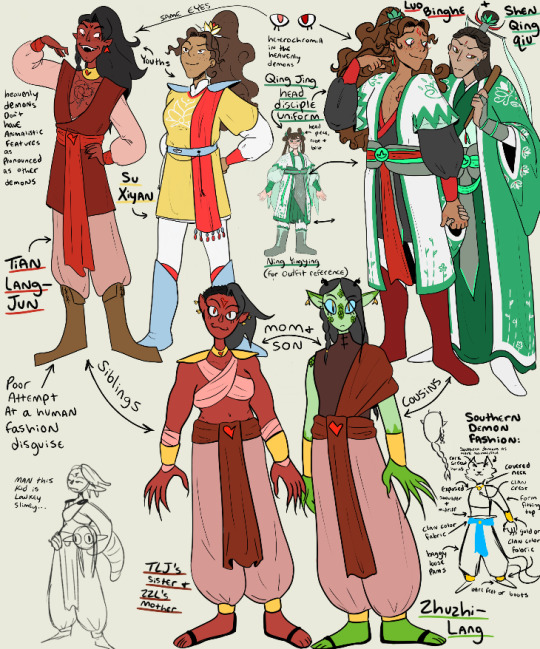
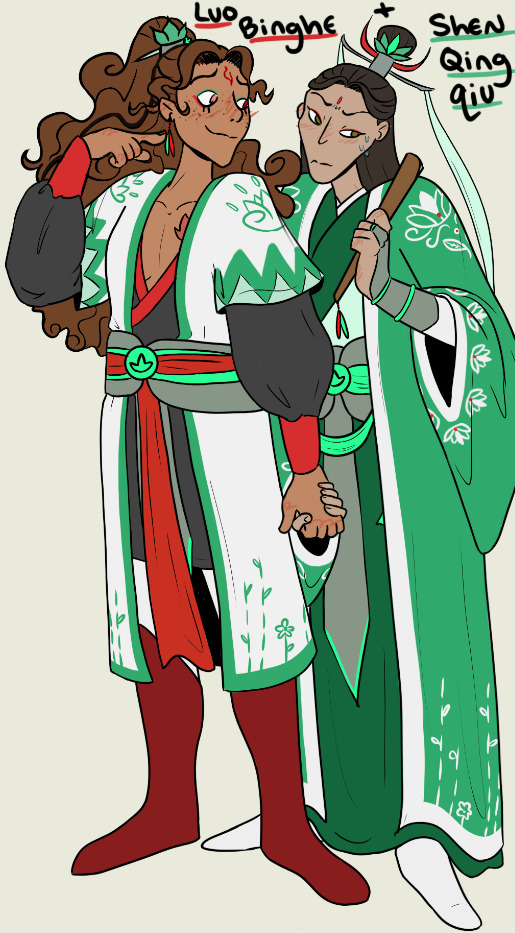

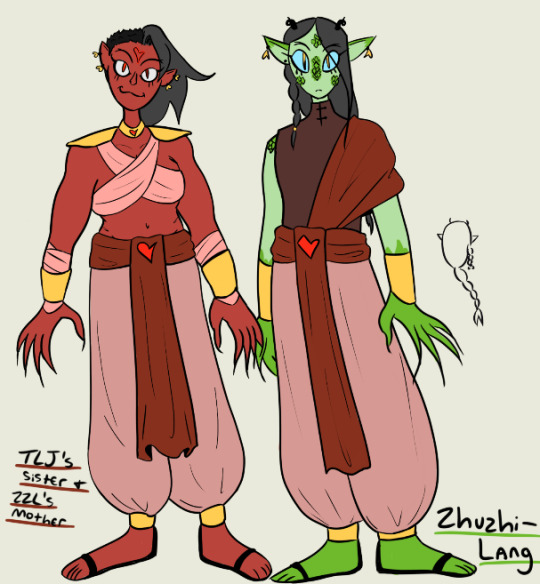
Part one of a mini Scum Villain design series I've been doing between work and assignments recently, mainly on the demons and their looks and fashion. First up: Luo Binghe's extended family. I've included some sketches and notes in that main picture, but I'll include some thoughts beneath the read more for if anyone is interested. Just keep in mind these are all head canons based on. my brain. and get a bit over explained and in depth (to the tune of 1k words) (in theory these is a read more here but uhhh rip):
Also keep in mind idk the official fashion names for stuff so I call things belts, robes, pants, ect even when that may not be the official term. if you know the official terms or even have guides or references I can use then please hmu and I will love you forever. Anyways:
Since TLJ ruled the southern kingdom and MBJ ruled the north, I've primarily divided the demon variants to be based around the directions. For most demons, I've got them in "clans" that really just denote what color fabric their belt is and what the design/color of the crest featured on most of them is. I imagine those sorts of simple visual signifiers make it easier for demons, especially lower class ones who may be unable to read, to identify friend or foe at a glance. I also wanted to have the demons wearing jewelry much more prominently than the humans do. As in like, the human fashion sense trends towards sensible, refined, and modest, and the demon fashion sense tends towards ostentatious, lax and boastful, though that ofc doesn't apply to everyone. This sorta stuff gets more relevant later for the designs of demons like Six Balls and Meng Mo.
For these lads (sans Binghe), they're southern demon based, as shown by the little cat demon design at the bottom right. Completely arbitrarily and just for the fun of it, I've got their primary clothing choices as being warm color fabrics paired with gold as a metal, form fitting tops with exposed stomachs, and baggy pants. Looser lighter fabrics allow for more flexibility for animalistic features or and body transformations that may happen. They're also typically in open toed shoes for similar reasons. Only Zhuzhi in this lineup has mini little horns, but I've also assigned each region a general horn shape (so edged and jagged for the north, spiral for the south, straight for the east and curved and wavy for the west). The only thing Binghe adopts from any demon style is the exposed chest, cloth on the belt, colors, and the demon mark.
I like giving the demons openly animalistic and beast like features, like colored skin, horns, fur/feathers/scales, claws, three fingers, ect, which again comes into play for the later demon designs I'm gonna post. For heavenly demons, however, since they're ancient fallen deities, I wanted them to skew more towards a human appearance. So while they have more vibrant skin and eyes, or sharper ears and fingers, they wouldn't have to put too much effort into a disguise or glamour to come off as a human.
Anyways, onto actually explaining what's happening in the pictures:
TLJ is attempting to appropriate human fashion choices, but has no idea what the line is. Like, he's aware they wear more fabric than demons, and have sleeves that fully cover their arms, but has no clue what pieces pair together and what fashion choices are clearly demon related that would get him recognized immediately. Like "what do you mean human's don't wear their clan crests everywhere? well how else do they define their enemies?!" Su Xiyan, meanwhile, is dressed in Huan Hua clothing. I wanted to make them distinct visually from Cang Qiong, so currently I have CQ having each peak have its own colors of robes (patterns and such denoting ranking), with each peak generally having a similar look and all of them (sans peak lords) wearing identical belts and boots, with the only variations being colors. Meanwhile, I have Huan Hua having everyone in the same gold silver white uniforms, with ranking denoted by accent colors and accessories they choose to wear. Like, if she was more self absorbed here, Su Xiyan could have worn a longer robe and a cape over that uniform but just chose not to. I like the idea of them wanting all their people to look the same, like an army or a hivemind.
Going to the bottom there: TLJ's Sister and ZZL's mother...what a figure. Like what was up with her. Like TLJ saying "if i had a mother like that I'd want to forget her too" like is that in reference to the abandonment or to her being a piece of work? Also, how on earth did the little sister of Mr "I'm so powerful a multi sect ambush of the top cultivators was only enough to imprison me" TLJ just casually died?? Like can heavenly demons even do that??? I love making up wild conspiracies about her based on nothing. She faked her death. She didn't die, she ascended to godhood as the god of deadbeat parents, or perhaps snake lovers. She dropped her mortal body to enter the dream realm like Meng Mo did and that's how she told TLJ her wish for ZZL. Wild. Oh also my other wild conspiracy is that she had more than one kid and thus there are a bunch of unclaimed half heavenly demons running around. Banging a snake man and ditching the kid?? Ain't no way that's her first time. Anyways.
My only comments on Zhuzhi are that I wanted to make him look like a little guy. And I hope I succeeded. Oh and also that his cheeks, nose, forehead, shoulder, hands, and feet are darker bc thats a cluster of harder scales he retains even in a humanoid form. Anyways.
Onto bingqiu: I've seen some art of Binghe in that white robe on top of his darker ones and had the thought that it'd be nice if that was the Qing Jing inner disciple robe, so I leaned into that. Their robes (as also shown on the little Ning Yingying next to him) are like a shorter color swapped version of the peak lord robes, and they're wearing similar belt and hair crowns. I think Binghe would wanna wear them partially to show off his disciple status and partially to wear the colors of his husband (like with the upper eyeliner), though he still has demon traits and fashions showing. I gave TLJ and LBH heterochromia since I wanted it to be immediately obvious to anyone who looked at them that yeah, they have the same eyes. Binghe's everything else is just slight adjustments of SXY, like the nose and the fluffy hair. Meanwhile, I've got SQQ in mainly his peak lord robes, with a few exceptions: The tassel on the closed fan he's holding is the same as Binghe's earring, he's wearing red eyeliner, and part of his hair crown is red. Also he's embarrassed about the pda (h*lding h*nds in public), that nervous expression isn't bc he was forced to do anything he doesn't want to.
Anyways to wrap up this one thousand word brain ramble, I have a lot of thoughts on world building for fleshing things out, and part two of this will be focused on Mobei Jun, thanks for reading
#svsss#scum villain self saving system#scum villain#scum villain fanart#svsss fanart#tianlang jun#su xiyan#luo binghe#shen qingqiu#zhuzhi lang#my art tag#my svsss char design series
103 notes
·
View notes
Text
Pokémon Society
As Humans are no longer around during the Ages of Ruin, the world’s order shifted to focus around Pokémon. Right now they’re divided into three classes.
The Roamers
These are Pokémon that don’t belong to any groups and tend to roam around the land on their own or in very small packs. They have a somewhat bad reputation among the other groups, as while it is incredibly rare for Pokémon to eat each other, Roamers are the most likely to do so. They’re also a bit rare as it’s hard for a lonely Mon to survive out alone in the world. Because of that they’re most commonly Dragon-types or something similarly powerful.
The Clans
Many Pokémon across the different regions, live in larger familial groups, known as clans. Right now they make up the biggest part of Pokémon society, as they offer good protection and a well organized support structure. It’s easier for clan Pokémon to find a Mate and raise children and the group also makes it possible to have healing and support Pokémon around as not every member of the clan needs to be able to fight. Moves like Healing Wish would be a big liability for Roamers but in a clan a Mon could use it to cure serious wounds on an other and then just sleep it of, as the move doesn’t copy wounds. Unfortunately they also make a good target for searching Hollows, which caused their numbers to dwindle since the second cataclysm, but they’re still a dominant Group as many strong Roamers have began to join them recently as the Hollows are an even bigger threat to a lone Mon even if they’re less likely to run into one.
The Cities
For the first few decades after humanity disappeared no Pokémon dared set foot into the old cities. But after that some ventured back in and discovered what was left behind. And so the cities became repopulated, though this time with Pokémon. Today the cities, while few and far between, are the second biggest fraction of Pokémon and unlike the clans they are more or less united. The federation of free cities, is a loose coalition of the various Pokémon towns spread across the world. Their number is much smaller than wenn the humans were still around and many old settlements have fallen into ruin and been forgotten by most. When the second cataclysm hit, the cities found themselves in a strange position, as their size made them frequent targets for Hollows, but their infrastructure made defense a lot easier. Because of that, right now the cities are considered to be the strongest faction in Pokémon society and many clans and Roamers seek to join them for safety purposes.
================================================
Masterpost
3 notes
·
View notes
Note
I’m the Belgian anon. I’m an immigrant (moved to Belgium while I was still a child tho) so maybe I have a different vision than other people. But Belgium is a divided country and not in the way people think the US is divided.
Belgium while small has a language border. In the north you have the Flemish who speak Dutch and in the south you have the Walloon who speak French. There’s very little holding the country together, each federal election it takes longer and longer to form a government and that’s because the north tends to vote more right wing (the northern part is also significantly richer) and the south tends to vote more left wing. Moreover the two largest parties by votes in the country are Flemish parties who favour a republic and an independent flanders. The south doesn’t really want to split but it doesn’t exactly get along with the nort. Since belgiums inception the French speaking part have oppressed the Dutch speaking (who make up the majority of the country), you didn’t have any higher education in Dutch, Flemish people were sentenced for crimes they couldn’t even understand as all judiciary was in French even if the court was situated in the Dutch speaking part. Brussels was originally Dutch speaking but over the decades it became French. There’s as a result a lot of resentment. Belgium didn’t even have the constitution in dutch until the late 70s despite the fact 60% speak dutch in the country. Since the 60’s there have been a lot of constitutional amendments (which were brought about by Flemish protest) that transformed the country from a unitary state to a federal state. Now the Royal Family is seen as Belgian when a lot of people don’t feel Belgian but identity more with their region. Also the RF speak French, queen fabiola barely spoke a word Dutch despite being the queen of a country where 60% speak that language. The current king and queen did send their kids to Dutch speaking schools which was a first (I think). But there’s not much connection with the rf.
We don’t have really a lot of pomp and ceremony (not in the way the British do, which I btw love 😂). So they aren’t really visible and yet seem to be taking a lot of money (which they totally are). We don’t have a soverings grant or anything, the government pays for the palaces and transport and the like but they also get a lump sum of money that’s considered a ‘salary’. In 2019 the king got around 13M€ of taxpayer money and the former king and queen and the siblings of the current king also receive a salary. So It’s like if Edward and Anne got salaries aside from their expenses (for representing the monarchy). The current king’s brother is also an absolute asshole. He once showed up in military uniform in a Chinese embassy party without the government approval, his salary as a result was lessend that asshole went and complained how his human rights were being violated. He actually went to European court of human rights!! And that’s not all he made several political moves with countries that were violating some serious human rights. He also was making shady deals (sounds familiar doesn’t it).
There’s also the whole mess with Albert II. He and his wife, Paola were estranged for a while. He had affairs and Delphine was born. He didn’t abandon her but playe daddy for a good number of years before his marriage rehabilitated and he completly refused to acknowledge her. She had to sue him and he wouldn’t recognise even then.
To me the royal family doesn’t do anything important for the country except leech of taxpayers. The majority in the north actually prefer to abolish the monarchy, we don’t really have a class system as in the UK so the idea of the monarchy seems just outdated. Also the king does have some influence in politics which is why I dislike it even more.
Most people are just kinda apathetic towards the monarchy. There aren’t really fervent monarchist in the way there are in the UK. Lol the people who show up at the mall every year for TTC wouldn’t happen in Belgium.
I read this when it was sent in and meant to post it yesterday but erdemgate happened, so y'know LOL
thank you so much, belgian anon! this was really interesting, and lines up with a couple of belgians i know who are quite apathetic about the royals there. i only really know princess elisabeth but that's just because she turned 18, and i doubt i'd know she existed if i wasn't here. i knew there were two languages but didn't realise there was such a divide politically, and i'm going to deep dive into this!!
i understand to an extent, wales is very divided between the north and south for political reasons (there's even two variations of welsh, but most people don't notice it) and we in the north often joke about breaking off and joining england lol
6 notes
·
View notes
Text
The Unexpected Moves Behind the Middle East’s Market Shock When it comes to the Middle East, there’s always something brewing beneath the surface. Today’s news, packed with ground operations, political whispers, and missile drills, has traders in a spin. But let's face it—what else could we expect from a region where the unexpected is the only constant? It seems Israel is on a mission, reportedly planning an imminent ground operation in Lebanon, according to Sky News Arabia (before they swiftly deleted that tweet—suspicious much?). No ceasefire is on the cards either, with Israel's Defense Minister Katz vowing to keep up the pressure on Hezbollah. In trading terms, this could mean the market's reaction will see more turbulence than a rollercoaster built by someone who skipped a few engineering classes. Strategic Implications: Beyond the Headlines Digging a bit deeper, the tensions here aren’t just about boots on the ground. Israeli Prime Minister Netanyahu, in conversations with close allies, seems to be hinting that when Trump gets back in the White House (if he does), he wants to revisit the idea of annexation. If you’re a trader, you know what that means—volatility on steroids. Markets don’t like uncertainty, and annexation is the financial equivalent of throwing a rock into an already murky pond. Meanwhile, the Palestinian divide between Fatah and Hamas remains as wide as ever—“no agreements” is the official word. For us traders, the failure to find unity means a steady drip of conflict-based instability, which could see spikes in commodity prices and fluctuations in currency pairs. Keep your eyes peeled—crisis often means opportunity, but only for those with the guts to navigate these choppy waters. US Influence: Playing the Long Game It’s not just the local actors at play here. US influence is heavy-handed, as usual. Reports have US officials stating that Netanyahu wants to end the Lebanon conflict within weeks. Also, Israeli Minister of Strategic Affairs has been briefing President-elect Trump on plans for Gaza and Lebanon—not exactly casual dinner talk, is it? Traders should note that US involvement usually brings the prospect of international repercussions, and often, a corresponding reaction in the markets. Remember, geopolitics can either make you or break you as a trader, and US involvement in the Middle East is a classic example of high stakes mixed with high rewards—if you can read between the lines. Missiles in the Channel—Russia Flexes And let’s not forget Russia, who never seems to want to be left out of the action. Their hypersonic missile carrier is apparently cruising through the English Channel, like a high-stakes flex aimed at showing everyone who’s got the real muscle. For traders, this bit of military theatre could foreshadow shifts in sentiment towards safe-haven assets like gold or the Swiss franc. When countries start waving around missiles, traders tend to grab onto something steady—and fast. Underground Trends You Need to Spot The most interesting part? It’s all about the underground trends. Market reactions to geopolitical developments aren’t always logical. Sometimes, it's the rumor mill that makes the most waves—like Sky News Arabia deleting that tweet. Traders who succeed here are those who understand that it’s not just the action itself, but how the world perceives it that moves the market. Consider this your wake-up call: now is the time to keep an eye on the correlation between Middle Eastern news and oil prices. History has taught us that when conflict escalates, energy prices tend to spike. Pair that with increased market chatter about annexation, and it could spell big moves in the USD and other currency pairs sensitive to global risk sentiment. The Forgotten Tactics that Still Work A quick reminder: it’s not just the flashy headlines that should be guiding your trading decisions. Revisit some of the forgotten tactics—such as focusing on smaller, cross-currency pairs that react to regional tensions rather than the bigger ones that are influenced by everything from rate decisions to Elon Musk's latest Tweet. Sometimes, the simplest approach is the most profitable—especially when everyone else is panicking. Hidden Forces Shaping Today’s Market As we wrap this up, let’s acknowledge the players behind the curtain. Iraqi armed factions reportedly targeted southern Israel with drones, and US forces struck back at pro-Iranian militias in Syria. Meanwhile, Ansar Allah outlets are reporting about US-British raids in Yemen. —————– Image Credits: Cover image at the top is AI-generated Read the full article
0 notes
Text
The Media: Conservative or Liberal
News media is ultimately dominated by various platforms, and according to the presentations we watched in class, we learned that radio listenership has declined in the last 10 years, news outlets and news magazines have gained millions of readers, and we even recognized the fact that social media has been brought to the center of attention simply because of how news corporations’ profit from cultural shifts and other major headlines. Certain media outlets tend to see an increase in viewership while others see declines due to political alignment and how divided things have become. One of the presentations that stood out was the one about “Web and News Sites & Social Media.” I think this one stood out to me personally because of the details and key information it provided about different social platforms and where they stand politically and why the percentage of viewership has gone up and down over time. The other presentations, mainly the one titled “Newspapers and Magazines” really focused on comparing different news corporations around the country and who has the upper hand in subscription and viewership ratings. I think this presentation, despite it being short, did dive into a lot regarding the decline of newspaper sales and the bias that exists within these corporations. The third presentation titled “Radio: Listeners/Viewers” made things clear in terms of what radio shows have the most listeners and why they garner so much attention as well as the demographics in terms of age and gender. I think these last two matter because of the region and long-standing political choices of many people. The last presentation, done by my group titled “A look into Broadcast”, we simply chose to compare different news outlets and then see where they stand in term of the total amount of viewers and what motivates them to choose certain news sources.
It is difficult to fully determine where the media around us really starts and begins in terms of where the political spectrum is applied and what issues matter the most to a specific audience. The media in the United States is often divided along the lines of being either conservative or liberal, but the reality is that it is more complex than that. I personally believe that the media landscape in the United States is made up of a variety of outlets the include television, powerful newspaper companies, magazines, radio, social media, and the internet. Each of these outlets has their own unique perspectives and can be seen as either liberal or conservative depending on the content they produce. When it comes to television, the major networks are often seen as being liberal. This is due to their focus on topics such as social justice, environmentalism, and progressive politics. They also tend to be more critical of the current administration and its policies. However, there are also some conservative-leaning networks like Fox News, which is known for its right-wing views. Newspapers are also seen as being either liberal or conservative. Major newspapers such as The New York Times and The Washington Post are often seen as being liberal due to their stance on progressive issues. However, there are also some conservative-leaning newspapers such as The Wall Street Journal and The National Review. Magazines are also seen as being either liberal or conservative. The major magazines such as Time and Newsweek are also seen as liberal leaning due to their focus on progressive issues. However, through some research that I did, I found out that there are also some conservative-leaning magazines such as The American Spectator and The National Review. Radio networks are also seen as being either liberal or conservative as well, for example, major radio networks such as NPR and BBC are labeled as being liberal due to their focus on more cultural issues and less politically aligned coverage. However, there are also some conservative-leaning radio networks such as Fox News Radio and the Glenn Beck Show. Social media is also seen as being either liberal or conservative. The major social media platforms such as Facebook and Twitter are often seen as being liberal due to their focus on liberal agenda related issues and a shift in the cultural approach towards the voices of big celebrities and athletes being heard. One conservative-leaning social media platform that comes to mind is Parler, which is considered to be an alternative to Twitter. Twitter, now owned by Elon Musk, has had its fair share in the departure of many liberal folks who used the platform to get their social concerns and messages across. The internet also provides a playing field where its role is to stir the mixture of liberal and conservative ideas that come together and where discussions regarding various controversial topics are addressed. In terms of search engines and ways to gain information using the internet, major websites such as Google and YouTube are often seen as leaning liberal because of various forms of censorship. Some conservative-leaning websites such as Breitbart and The Daily Caller have been more successful when it comes to the catering of conservative viewers and readers, where the appeal is stronger and more favorable, especially in a time when many people still want former President Trump to regain the presidency one day. When it comes down to who owns the media, the answer is complex. The media landscape in the United States is dominated by a handful of large corporations such as Comcast, Disney, AT&T and News Corp, who own over 90 percent of the media we consume daily. These corporations own many smaller regional media outlets. Overall, the media empire within the United States is not necessarily conservative or liberal. It is a complex landscape with a variety of perspectives.
It is also a good point to make when I personally say that there are also some outlets that are more balanced in their coverage. Ultimately, it is up to the individual to decide which outlets they trust and which ones they don't.
1 note
·
View note
Text
The Media: Conservative or Liberal?
News media is ultimately dominated by various platforms, and according to the presentations we watched in class, we learned that radio listenership has declined in the last 10 years, news outlets and news magazines have gained millions of readers, and we even recognized the fact that social media has been brought to the center of attention simply because of how news corporations’ profit from cultural shifts and other major headlines. Certain media outlets tend to see an increase in viewership while others see declines due to political alignment and how divided things have become. One of the presentations that stood out was the one about “Web and News Sites & Social Media.” I think this one stood out to me personally because of the details and key information it provided about different social platforms and where they stand politically and why the percentage of viewership has gone up and down over time. The other presentations, mainly the one titled “Newspapers and Magazines” really focused on comparing different news corporations around the country and who has the upper hand in subscription and viewership ratings. I think this presentation, despite it being short, did dive into a lot regarding the decline of newspaper sales and the bias that exists within these corporations. The third presentation titled “Radio: Listeners/Viewers” made things clear in terms of what radio shows have the most listeners and why they garner so much attention as well as the demographics in terms of age and gender. I think these last two matter because of the region and long-standing political choices of many people. The last presentation, done by my group titled “A look into Broadcast”, we simply chose to compare different news outlets and then see where they stand in term of the total amount of viewers and what motivates them to choose certain news sources.
It is difficult to fully determine where the media around us really starts and begins in terms of where the political spectrum is applied and what issues matter the most to a specific audience. The media in the United States is often divided along the lines of being either conservative or liberal, but the reality is that it is more complex than that. I personally believe that the media landscape in the United States is made up of a variety of outlets the include television, powerful newspaper companies, magazines, radio, social media, and the internet. Each of these outlets has their own unique perspectives and can be seen as either liberal or conservative depending on the content they produce. When it comes to television, the major networks are often seen as being liberal. This is due to their focus on topics such as social justice, environmentalism, and progressive politics. They also tend to be more critical of the current administration and its policies. However, there are also some conservative-leaning networks like Fox News, which is known for its right-wing views. Newspapers are also seen as being either liberal or conservative. Major newspapers such as The New York Times and The Washington Post are often seen as being liberal due to their stance on progressive issues. However, there are also some conservative-leaning newspapers such as The Wall Street Journal and The National Review. Magazines are also seen as being either liberal or conservative. The major magazines such as Time and Newsweek are also seen as liberal leaning due to their focus on progressive issues. However, through some research that I did, I found out that there are also some conservative-leaning magazines such as The American Spectator and The National Review. Radio networks are also seen as being either liberal or conservative as well, for example, major radio networks such as NPR and BBC are labeled as being liberal due to their focus on more cultural issues and less politically aligned coverage. However, there are also some conservative-leaning radio networks such as Fox News Radio and the Glenn Beck Show. Social media is also seen as being either liberal or conservative. The major social media platforms such as Facebook and Twitter are often seen as being liberal due to their focus on liberal agenda related issues and a shift in the cultural approach towards the voices of big celebrities and athletes being heard. One conservative-leaning social media platform that comes to mind is Parler, which is considered to be an alternative to Twitter. Twitter, now owned by Elon Musk, has had its fair share in the departure of many liberal folks who used the platform to get their social concerns and messages across. The internet also provides a playing field where its role is to stir the mixture of liberal and conservative ideas that come together and where discussions regarding various controversial topics are addressed. In terms of search engines and ways to gain information using the internet, major websites such as Google and YouTube are often seen as leaning liberal because of various forms of censorship. Some conservative-leaning websites such as Breitbart and The Daily Caller have been more successful when it comes to the catering of conservative viewers and readers, where the appeal is stronger and more favorable, especially in a time when many people still want former President Trump to regain the presidency one day. When it comes down to who owns the media, the answer is complex. The media landscape in the United States is dominated by a handful of large corporations such as Comcast, Disney, AT&T and News Corp, who own over 90 percent of the media we consume daily. . Overall, the media empire within the United States is not necessarily conservative or liberal. It is a complex landscape with a variety of perspectives.
It is also a good point to make when I personally say that there are also some outlets that are more balanced in their coverage. Ultimately, it is up to the individual to decide which outlets they trust and which ones they don't.
0 notes
Photo

Personal design of UF!Papyrus, codex name “Aureus.” :D
About him and the Underfell setting:
All monsters are required to begin military training as children. Every so often there are trials -- essentially deadly puzzles and obstacle courses -- and tournaments to weed out the weak and elevate the strong. These are subdivided by region and age; all adults of a region compete together, but younger monsters have multiple age brackets. After progressing far enough in the tournament, the fights stop being to-the-death and become about wealth, power, and status. In the adult competitions, the monsters who perform best are recruited to the Royal Guard.
Aureus oversees Snowdin Town as its chief commander (which, as all political positions are also military ones, makes him basically the mayor). He is very personally involved in both youth training and upkeep of the adult militia, and does his best to ensure his trainees and soldiers are capable of surviving. He wants to keep as many of them alive as possible.
Along with combat training, he designs his own puzzle trials that aim to simulate the official ones but do not actually kill the participants, so they can practice to perform better when their lives are on the line. Most of Snowdin Town deeply respects him, but he has trouble with closer interpersonal connections both because of his status and his larger than life personality.
He pushes people hard, and can be overbearing and controlling because he takes his responsibilities very seriously and tends to think people should just listen to him. He has a lot of people's lives on his shoulders... and the gravity of that makes him very assertive and sometimes uncompromising. But it really is all about trying to keep the people under his care safe. Although he looks intimidating, his usual demeanor is friendly and energetic, if somewhat forceful. He's just as genuinely encouraging as he can be demanding.
Aureus doesn't believe anyone is expendable. Everyone has something to offer if they're given the chance to learn and develop. The most heartbreaking thing for him is that not everyone is going to get that chance -- children who might otherwise be late bloomers aren't going to make it through their first trials; that’s part of why he pushes so hard. Even for the most skilled, however, simple mistakes can happen. Inevitably some people won’t make it through. Aureus can't save everyone... but he really does his damndest.
Because of how bleak things generally are, Aureus regularly organizes town festivals to try to keep up morale. Ruber (UF!Sans) helps him with this and is often the one to “break the ice” and get their neighbors into a festive mood, but Aureus himself is quite social and lighthearted at these events.
Snowdin is still considered pretty backwater and therefore low-status, but Aureus's personal friendship with Undyne helps him with requisitioning enough to keep the townsfolk mostly safe and fed, supplemented with Ruber's backchannel gains. Conditions are much worse for the "lesser class" monsters in the more densely populated regions of Hotland and New Home, where the class divide is a lot starker. Waterfall is decently propserous, as Undyne has a fondness for her home region, but even there, people are mindful of their status.
Snowdin's always been a little less rigid because it's so far away from the real centers of power that "anybody who's anybody" doesn't want to be there. There HAVE been bitter, abusive people in charge there before, but under Aureus's command and oversight, the town's culture is much more harmonious and focused on everyone working together to survive. And he is quick to remind people that “even someone from a backwater town can become a great war hero if they try hard enough!!!!”
25 notes
·
View notes
Text
(a bit of world building regarding pre-Union Hebitian governments)
For a significant portion of Hebitian history, it was believed that a select few families were directly descended from the gods, and could trace themselves back to Oralius through those gods. These families therefore had hereditary positions of power, functionally forming a council that presided over various matters. Different states were ruled by councils that had slightly different makeups of people whose families claimed descent from gods. A survey of what records outside academics have been allowed to read by Hebitians, or from books sold on the antiquities market, suggests there are ultimately 24 families that were recognized by all Orallaists as having legitimate claim to this descendancy, with the distinct regional makeup resulting in some families that had dubious legitimacy. These families also had slightly different claims regarding which gods they were descended from. They tended to intermarry, as is common in governments where legitimacy is partially based on the belief in hereditary connection to the divine. Around the 13th century, a cascade of council votes across regions led to the regulation that no one could marry anyone more closely related than a second cousin.
The idea that a person could function as a conduit for a god or gods was important in Hebitian culture and shows up in many different ways, not just through this form of government. The divine origin associated with Hebitian leaders has been held onto by some, but largely discarded by the community, with guides and "voices" taking predominance. Both roles in the community are determined either by spiritual study or spiritual experiences, respectively, and as all Hebitians were disprivileged, without regard for former class divides, said class divides are not a factor in access to study. Additionally, "voices" have always come from every aspect of society, and were essentially the primary leaders in folk religion.
Different regions tended to be dominated by a specific group of Hebitians, forming their own recognized territories. These were primarily based around agricultural rights. Warfare over land and water as a result did occur, but it was preferred to have councils meet and come to a conclusion regarding whatever dispute. If people acted against the decision of their council, they were legally considered bandits and could be prosecuted by both their council and the council of whatever party they wronged.
The Hebitian historical record shows that the council system originally came from a monarchist system. The monarch in an area would marry multiple people, who then were put in charge of various aspects of the government (military, Agriculture, etc). Both the monarch and their spouses were usually from families believed to have divine heritage. Exceptions in the spouses occasionally occurred because of personal affection or in cases where astrological signs pointed to the match being auspicious. The monarch reached their position either because the local area had a family they believed to be highest, or by winning competitions against candidates from other families.
The transition from the monarchist system to the council system occurred after a particularly stupid king's spouses decided to overthrow him and make it so all the families had equal say over the government. The council system is thought to have influenced the Cardassian government but due to censorship and propaganda, it's hotly debated by scholars outside Cardassia whether it was adopted when the Union was formed in the form of the Detapa council or if it's older (which is what the Cardassian government claims) and if so, how old it is.
It is thought that this system of kingship and marriage greatly contributed to a more relaxed Hebitian attitude about same sex relationships (though the Cardassian attitude cannot in itself be called wholly disdainful; Cardassian social mores are much more greatly concerned with gender). While it was socially greatly preferred to have many children, the fact is that no king had spouses of only one gender, and while it wasn't required to have sexual relationships with all of their spouses, they used the same legal ties as a commoners marriage.
17 notes
·
View notes
Note
Hi!! I wanted to ask about the RCU and the sorta mixing of cultures, overlap, and the pigin language from the wither rose trade language (I feel like Im mangling that word-)
hi!! sorry it took a few days for me to answer your question, i got sick irl
so i feel like this question is specifically focused on the Wither Rose Alliance kingdoms? (if i'm mistaken my bad lmao) so i'm going to answer based on those 4--being Mythland, the Grimlands, and the Crystal Cliffs as the 3 founding members, and then Smallhold as the most recent official addition.
all 4 kingdoms have their own distinct cultures, and describing them all in detail would require 4 separate posts, so i'll give a basic summary here. The Grimlands: technologically advanced, with a strong cultural focus on the sciences, logic, and reason. they are very stoic and tend not to show emotion often. highly anti-magic; they see magic as unpredictable and irrational. highly progressive, with technological innovations coming down the pipeline often.
The Crystal Cliffs: magically advanced, with a strong cultural tie to arcane magic in particular (as opposed to nature magic). they prioritize learning, accumulating knowledge, and gaining wisdom. they think the Grimlands' views on magic are stupid, but their allyship is so close that they graciously look the other way.
Mythland: HUGE, very rich, and very powerful. large divide between the wealthy upper class and the poor lower class. massive trade nexus. rich, deep cultural/religious beliefs involving blood, most rituals require blood to be spilled (usually by pricking a thumb or palm).
Smallhold: small, as the name would suggest, but powerful in trade because they are a food-producing breadbasket. one of the few nations to democratically elect a ruler. deeply tied to the earth, nature magic, seasons, the harvest, etc. and have a strong cultural focus on protecting, nurturing, and attending to the land.
now obviously some of these cultural elements--for example the Grimlands' distaste for magic and the Cliffs' love of it--can't really overlap. however, lots of things do, especially in the empires that are nearest each other. common languages, for one--the Grimlands/Cliffs both speak Grimmish as a mother tongue, while Mythland/Smallhold both speak Mythik. there are also common regional folktales, common popular historical figures, etc., as well as the Wither Rose Alliance Festival, which is hosted each summer in Mythland and celebrates the creation of the alliance around 700 years ago. entertainers, speakers, and guests from every kingdom come to this, and it's where you'll see the most cultural mixing.
Wither-Common is also a uniting factor, and in some regions (especially merchant-heavy ones) it's actually spoken more often than Grimmish or Mythik. it is a pidgin language, created for trade, and borrows grammar and vocabulary from both Mythik and Grimmish, so speakers of both can usually understand it okay. as most pidgins do, it started out very simple and sparse, but evolved over time into a vibrant and flourishing language of its own.
i hope this answered your question! :]
#empires smp#mcyt#wither rose alliance#the grimlands#the crystal cliffs#mythland#smallhold#fwhip#geminitay#mythicalsausage#pearlescentmoon#rcu#answered asks#goldensongstriss
33 notes
·
View notes
Note
I'm a Chinese, nationally and racially. Racial projection seems to be a common practice in western fandom, doesn't it? I find it a bit... weird to witness the drama ignited upon shipping individuals with different races, or the tendency to separate characters into different "colors" even though the world setting doesn't divide races like that. Such practice isn't a thing here. Mind explaining a bit on this phenomenon?
--
Sure, I can try. But of course, fish aren’t very good at explaining the water they swim in.
Americans aren’t good at detecting our own Americanness, and a lot of what you’re seeing is very much culturally American rather than Western in general. (In much of Europe, “race” is a concept used by racists, or so I’m told, unlike in the US where it’s seen more neutrally.) Majority group members (i.e. me, a white girl) aren’t usually the savviest about minority issues, but I’ll give it a shot.
The big picture is that most US race stuff boils down to our attempts to justify and maintain slavery and that dynamic being applied, awkwardly, to everyone else too, even years after we abolished slavery.
There’s a concept called the “one drop rule” where a person is “black” if they have even one drop of black blood.
We used to outlaw “interracial” marriage until quite recently. (That meant marriage between black people and white people with Asians and Hispanic people and others wedged in awkwardly.) Here’s the Wikipedia article on this, which contains the following map showing when we legalized interracial marriage. The red states are 1967.
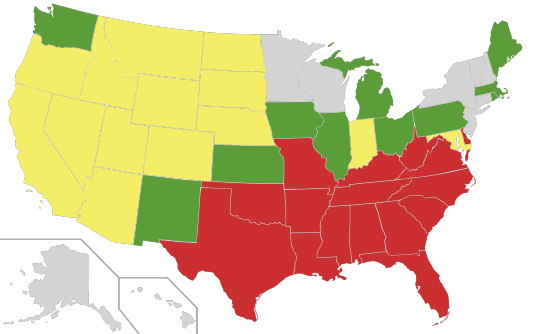
That’s within living memory for a ton of people! Yellow is 1948 to 1967. This is just not very long ago at all. (Hell, we only fully banned slavery in 1865, which is also just not that long ago when it comes to human culture.)
Why did we have this bananas-crazy set of laws and this idiotic notion that one remote ancestor defines who you are? It boils down to slavery requiring a constant reaffirming that black people are all the same (and subhuman) while white people are all this completely separate category. The minute you start intermarrying, all of that breaks down. This was particularly important in our history because our system of slavery involved the kids of slaves being slaves and nobody really buying their way out. Globally, historically, there are other systems of slavery where there was more mobility or where enslaved people were debtors with a similar background to owners, and thus the people in power were less threatened by ambiguity in identity.
Post-slavery, this shit hung around because it was in the interests of the people in power to maintain a similar status quo where black people are fundamentally Other.
A lot of our obsession with who counts as what is simply a legacy of our racist past that produced our racist present.
--
The other big factor in American concepts of identity is that we see ourselves as a nation of immigrants (ignoring our indigenous peoples, as usual). A lot of people’s families arrived here relatively recently, and we often don’t have good records of exactly where they were from, even aside from enslaved people who obviously wouldn’t have those records. Plenty of people still identify with a general nationality (”Italian-American” and such), but the nuance the family might once have had (specific region of Italy, specific hometown) is often lost. Yeah, I know every place has immigrants, and lots of people don’t have good records, but the US is one of those countries where families have on average moved around a lot more and a lot more recently than some, and it affects our concepts of identity. I think some of the willingness to buy into the idea of “races” rather than “ethnicities” has to do with this flattening of identity.
New immigrant groups were often seen as Other and lesser, but over time, the ones who could manage it got added to our concept of “whiteness”, which gave them access to those same social and economic privileges.
Skin color is a big part of this. In a system that is founded on there being two categories, white owners and black slaves, skin color is obviously going to be about that rather than being more of a class marker like it is in a lot of the world.
But it’s not all about skin color since we have plenty of Europeans with somewhat darker skin who are seen as generically white here, while very pale Asians are not. I’m not super familiar with all of the history of anti-Asian racism in the US, but I think this persistent Otherness probably boils down to Western powers trying to justify colonial activities in Asia plus a bunch of religious bullshit about predominantly Christian nations vs. ones that are predominantly Buddhist or some other religion.
In fact, a lot of racist archetypes in English can be traced back to England’s earliest colonial efforts in Ireland. Justifying colonizing Those People because they’re subhuman and/or ignorant and in need of paternalistic rulers or religious conversion is at the bottom of a lot of racist notions. Ironic that we now see Irish people as clearly “white”.
--
There are a lot of racist porn tropes and racist cultural baggage here around the idea of black people being animalistic. Racist white people think black men want to rape/steal white women from white men. Black women get seen as hypersexual and aggressive. If this sounds like white people projecting in order to justify murder and rape... well, it is.
Similar tropes get applied to a lot of groups, often including Hispanic and Middle Eastern people, though East Asians come in more for creepy fantasies about endlessly submissive and promiscuous women. This nonsense already existed, but it was certainly not helped by WWII servicemen from here and their experiences in Asia. Again, it’s a projection to justify shitty behavior as what the party with less power was “asking for”.
In porn and even romance novels, this tends to turn up as a white character the audience is supposed to identify with paired with an exotic, mysterious Other or an animalistic sexy rapist Other.
A lot of fandoms are based on US media, so all of our racist bullshit does apply to the casting and writing of those, whether or not the fic is by Americans or replicating our racist porn tropes.
(Obviously, things get pretty hilarious and infuriating once Americans get into c-dramas and try to apply the exact same ideas unchanged to mainstream media about the majority group made by a huge and powerful country.)
--
Politically, within the US, white people have had most of the power most of the time. We also make up a big chunk of the population. (This is starting to change in some areas, which has assholes scared shitless.) This means that other groups tend to band together to accomplish shared political goals. They’re minorities here, so they get lumped together.
A lot of Americans become used to seeing the world in terms of “white people” who are powerful oppressors and “people of color” who are oppressed minorities. They’re trying to be progressive and help people with less power, and that’s good, but it obviously becomes awkward when it’s over-applied to looking at, say, China.
--
Now... fandom...
I find that fandom, in general, has a bad habit of holding things to double standards: queer things must be Good Representation™ even when they’re not being produced for that purpose. Same for ethnic minorities or any other minority. US-influenced parts of fandom (which includes a lot of English-speaking fandom) tend to not be very good at accepting that things are just fantasy. This has gotten worse in recent years.
As fandom has gotten more mainstream here, general media criticism about better representation (both in terms of number of characters and in terms of how they’re portrayed) has turned into fanfic criticism (not enough fics about ship X, too many about ship Y, problematic tropes that should not be applied to ship X, etc.). I find this extremely misguided considering the smaller reach of fandom but, more importantly, the lack of barriers to entry. If you think my AO3 fic sucks, you can make an account and post other fic that will be just as findable. You don’t need money or industry connections or to pass any particular hurdle to get your work out there too.
People also (understandably) tend to be hypersensitive to anything that looks like a racist porn trope. My feeling is that many of these are general porn tropes and people are reaching. There are specific tropes where black guys are given a huge dick as part of showing that they’re animalistic and hypersexual, but big dicks are really common in porn in general. The latter doesn’t automatically mean you’re doing the former unless there are other elements present. A/B/O or dubcon doesn’t mean it’s this racist trope either, not unless certain cliched elements are present. OTOH, it’s not hard for a/b/o tropes to feel close to “animalistic guy is rapey”, so I can see why it often bothers people.
A huge, huge, huge proportion of wank is “all rape fantasies are bad” crap too, which muddies the waters. I think a lot of people use “it’s racist” as an easy way to force others to agree with their incorrect claims that dubcon, noncon, a/b/o, etc. are fundamentally bad. Many fans, especially white fans, feel like they don’t know enough to refute claims of racism, so they cave to such arguments even when they’re transparently disingenuous.
--
Not everyone here thinks this way. I know plenty of people offline, particularly a lot of nonwhite people, who think fandom discourse is idiotic and that the people “protecting” people or characters of color are far more racist than the people writing “bad” fic or shipping the wrong thing.
But in general, I’d say that the stuff above is why a lot of us see the world as white people in power vs. everyone else as oppressed victims, interracial relationships as fraught, and porn about them as suspect. Basically, it’s people trying to be more progressive and aware but sometimes causing more harm than good when those attempts go awry.
169 notes
·
View notes
Note
Hey, Cuba-anon again with a slightly different question. Less about Cuba, more about foreign policy and ethics in general. I am interested to know what you think about Nationalism and it’s place in the modern world. How should one view their relationship to their country versus their relationship to the global community?
To give my point of view, I think I am a pragmatic nationalist? I am not gung-ho about America because “it is the best nation ever and the president is never wrong, uwu”, but rather because I live here, my parents and grandparents live here, and if something in the world negatively impacts America it will by extension negatively impact me. I don’t think other countries are beneath me or anything, but I also know that the feeling is not always reciprocal. So, to me, putting the well being of Americans first and everything else second is similar to putting on your air mask first before helping others in the event of a plane crash.
Either way, would love to hear your point of view and see how others tackle the question.
(sorry for the delay in response, got halfway through writing this then saved it to drafts and completely blanked on it)
But okay, interesting question, and worth breaking down.
So, you know how through the '90s and early 2000's there was this just utterly overpowering narrative where the last chapter of every history textbook ended with a chapter about how national borders were less and less important and how through the magic of The Internet young people were more connected and cosmopolitan than ever, with the strong implication that the weight of history was pulling us inevitably towards a post-national utopia of frictionless exchange and understanding. Call it the Star Trek ideal.
Hasn't exactly worked out, of course. And to a large degree was bullshit even at the time (or the optimism of academics expecting all of humanity to think like they do, being charitable). But in my heart of hearts, that's still how I think things should work.
But okay, to get a bit less abstract, a bunch of barely connected thoughts-
- Nation-states (and states generally) are, at best, convenient administrative divisions of humanity. They have no value outside the services they provide to their residents, and certainly no rights or moral worth outside that. America doesn't deserve your loyalty or life anymore than the state of Ohio or city of Baltimore do (replace with wherever you live.)
-If you accept the basic idea of humans having equal moral worth (or anywhere close to it), then the entire idea that someone's entire life should be defined by what side of an imaginary line on a map they were born on seems obviously absurd as soon as you start thinking about it?
-Nations - in terms of borders, whose included, what characteristics are 'national', etc - are also both contingent and a great extent artificial, defined by state and cultural elites via a standardized language, a mythologized national history, patriotic holidays, nationalizing and creating traditions and rituals, national education and entertainment, etc, etc. There's nothing primordial or inherent there.
-Unfortunately, people really, really like having teams to identify with, and like excluding people from those teams and/or treating them like shit for not belonging to them even more. (People talk a lot about x or y horrible thing being fundamental to human nature, but I really think this is one of the places where human nature really lets us down.)
-Nationalism is an extremely easy and powerful way of dividing the world between us and them, and across the world there has been massive success using it as a locus for identity formation and to organize populations around basically every sort of project imaginable, from funding public education and welfare to genocide.
-Nationalism is, as mentioned, inherently exclusive - and no matter what it's proponents say, in practice there's always someone within the borders of the nation who doesn't quite fit (in the European context, Romani and Jewish people are the most obvious examples). Cases where the nationalist imagination doesn't perfectly overlap with state borders, or with the identity of some subset of the 'national' population also tends to go, uh, badly.
-However, within the national population, appeals to national solidarity or theoretically shared ideals can often be (to a limited degree) useful in transcending or working to ameliorate regional, ethnic, class, etc divides.
-While it's true that large chunks of the American (Canadian, British, French, Japanese, etc) populace benefit quite a bit from their position in the current international system, it's almost universally the case that what foreign policy elites consider 'the national interest' extends far, far, far beyond anything that provides concrete benefits to the average citizen - I'll just gesture vaguely towards Afghanistan, here. Or World War 1 - and quite a lot of death and misery is inflicted for the sake of a narrow slice of the elite's material interests and entirely meaningless concerns around national glory and prestige.
-To be frank, in specifically America's case, putting the interests of co-nationals first and everyone else second is less putting your own air mask on first and more launching a life boat at half capacity to make sure you have leg room.
-But, again, the fruits of pursuing the national interest really, really aren't evenly spread. Does the US government's tireless and vicious championing of stringent IP laws, regardless of how many needless deaths result from the constraints on the drug supply they create, really do much for the average American?
-Which, to go back to the air mask analogy, brings up the awkward point that very often it's not so much putting your own mask on first as tearing the masks off people around you so you have extras, just in case. How much less is the life of someone on the wrong side of the border worth? Half as much? A tenth? A thousandth? The pursuit of America's national security and national interests has a death toll well into the millions.
-Honestly, even if you don't care at all about foreigners, in terms of domestic policy it's just a useful heuristic to instinctively distrust anyone who relies too much on nationalist rhetoric to justify themselves. I mean, the music's almost always bad and anyone who actually gets invested in the symbolism of their flag is reliably a complete killjoy, but even beyond that - they're just very reliably the worst people. This is admittedly unkind and not always true. But, well, see that quote about patriotism being the last refuge of the scoundrel, which applies wonderfully to both people and organizations. If someone's trying to sell something by wrapping it in the flag, that usually means they don't want you looking too closely.
-Viewing the world through a nationalist framework and caring about zero-sum issues of national prestige also make it incredibly hard to coordinate around issues that don't care about national borders, or are going to disproportionately hurt people without rich and powerful nation-states defending their interests. Like, I don't know, global pandemics. Or climate change.
-Anyway, in conclusion, borders bad, nationalism bad, and also any officially codified 'Patriotic' culture is instantly cringe. Hopefully some of this makes sense.
64 notes
·
View notes
Text
Star Wars Alien Species - Devaronian
Devaron was the home world of the Devaronians. It was located in the Colonies, near the Corellian Trade Spine. It was a planet of low mountains and deep valleys linked by thousands of rivers.

First devising the tumble hyperdrive around 27,000 BBY, Devaronians were one of the first species in the galaxy to develop interstellar travel. The males of the species had been common sights in spaceports throughout the galaxy for thousands of years by the time of the Galactic Civil War.
Devaronian males were driven by an urge to wander, usually taking the first opportunity to move on from one place to another. As such, they were often found traveling the galaxy as tramp freighter captains and scouts. Female Devaronians, on the other hand, were content to remain in a single location, and, as such, raised the young and ran the government of Devaron. The males sent as much money as they could manage back to their homeworld to support their families, but otherwise hardly ever returned once they had begun to travel the stars. The females were content with this arrangement, as they tended to view the restless males as disruptive to home life. Mating rituals consisted of the season of Koh'hibril. Females were dominant therefore, as that was the only time couples spend long periods together. "Oshmahr" was a mid-day meal ceremony of the Devaronians.
Force-sensitivity was found in higher frequencies among Devaronians than in other species. Despite this, no strong Force-based tradition emerged on Devaron or among their colonies. The Jedi Order established the Eedit Temple on Devaron to train the Forceful children there, with females making up the larger percentage of students as males desired to travel more than the Jedi culture permitted.
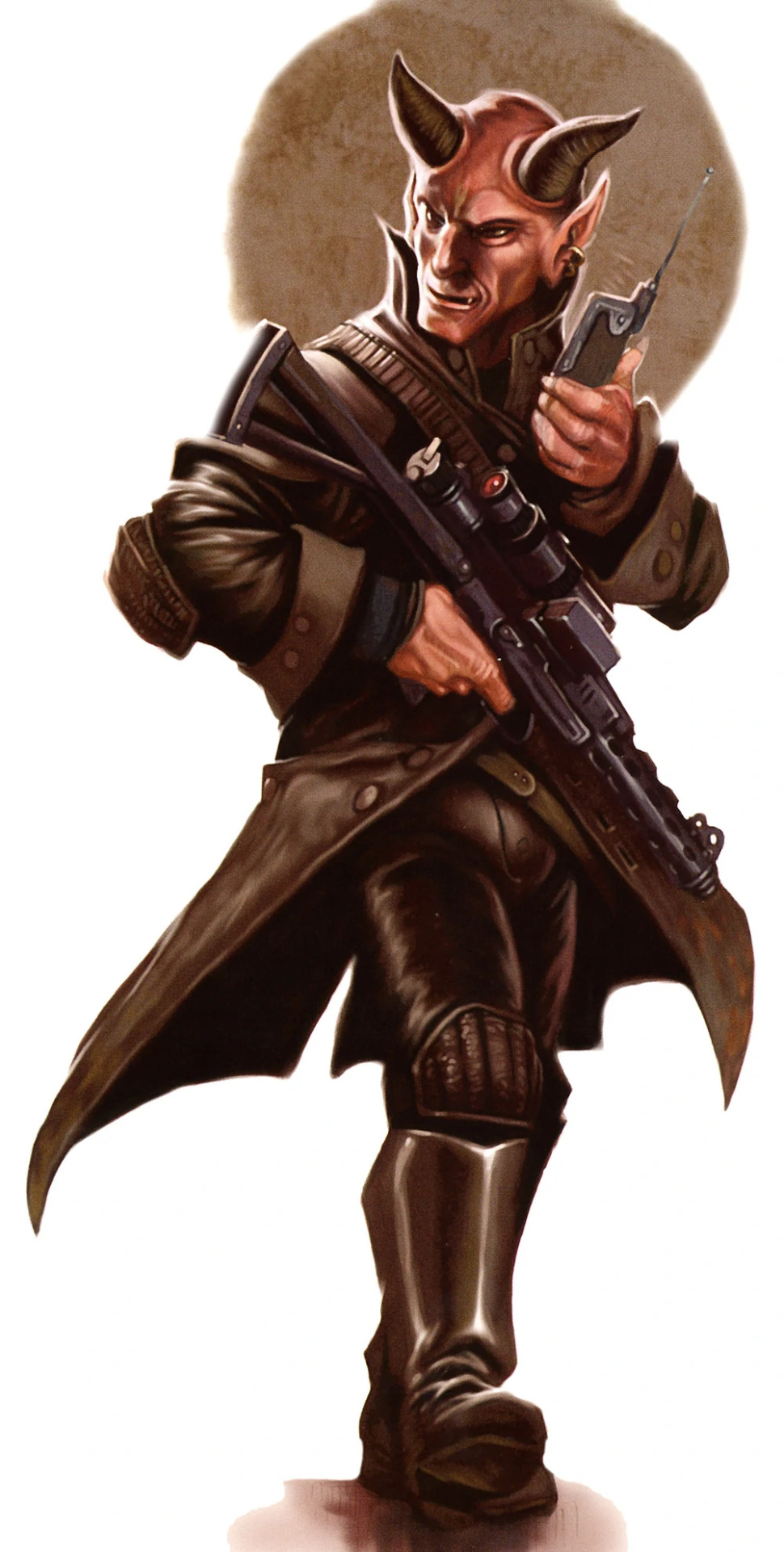
Developing hyperspace technology as early as 30,000 BBY, the Devaronian culture had developed quickly from hunter-gatherers to an industrial power in a short amount of time. The species developed a divide in gender roles during their tribal stage when males had to travel several days from settlements to hunt for prey while the females maintained the safety and organization of the camp. While the matriarchal government developed and funded space technology, it was the wanderlust of the males which drove the species to the stars and beyond. Exploring the region of space around Devaron, Devaronian explorers made contact with other hyperspace scouts and helped blaze the Corellian Trade Spine. One of the earliest planetary governments to join the Galactic Republic, sometime between 25,000 BBY and 22,000 BBY, Devaron was one of the farthest points in known space, forming a border with Wild Space for millennia.
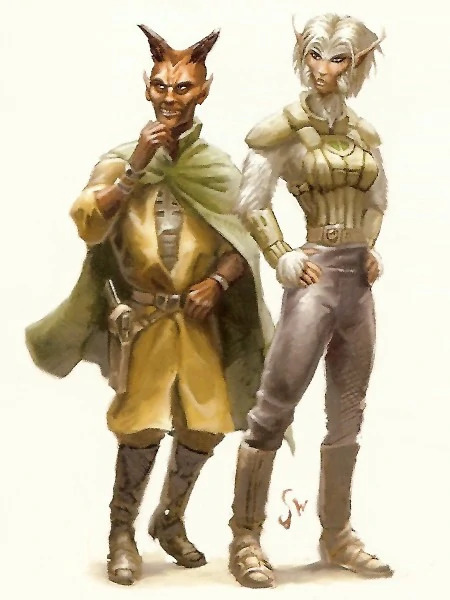
While the government of Devaron was a representative government that matured to a point where the strict divisions between gender roles was blurred, Devaronian females were historically the most prestigious government officials. To this end, the government was largely matriarchal, as males sought out roles that better suited their primal wanderlust that drove them into the jungles or the stars.
During the Jedi Civil War, the planet was the site of a battle won by the Republic. Devaron was represented in the Galactic Senate jointly by Elsah'sai'Moro and Vien'sai'Malloc during the final days of the ancient democracy. However, in 22 BBY, Elsah was assassinated by Aurra Sing who had been hired by Vien, who was herself arrested (and presumably executed) for both her assassination attempt and her secret sponsoring of a Separatist base in the Blue Mountains. In that same year, bounty hunter Cad Bane attacked a Republic outpost on the planet in order to capture Jedi Master Bolla Ropal, who was the keeper of the Kyber memory crystal, which contained a list of Force-sensitive children in the Galaxy. Later, Jedi Knight Anakin Skywalker and his Padawan Ahsoka Tano arrived in the Star Destroyer Resolute in order to reclaim the holocron. During the battle, the Resolute later engaged Bane's Munificent-class star frigates. Bane managed to escape, but the bounty hunter fleet was destroyed.
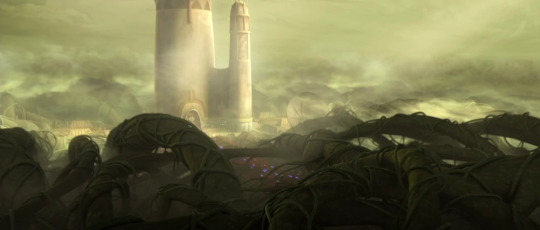
Later in the war, the Temple of Eedit on Devaron was attacked by Separatist forces. This battle was the first appearance of Count Dooku's new apprentice Savage Opress and where Jedi Halsey and his Padawan Knox died. Under President Aven'sai'Ulrahk, the planet continued to support the Republic throughout the rest of the war before falling under the sway of the Galactic Empire following the war's end. Around 5 BBY, Devaron was the site of an uprising against the Empire, which was put down by the Imperial-aligned Devaronian Army, led by Kardue'sai'Malloc, whom was thus called the "Butcher of Montellian Serat". To escape persecution, the Butcher fled to Tatooine and changed his name to Labria. In 19 ABY, Boba Fett captured Labria and took him to Devaron, where the Butcher was executed.
The planet was denied membership in the New Republic due to its violent capital punishment. During the Yuuzhan Vong War, the planetary government of Devaron attempted to appease the Yuuzhan Vong by offering Jedi Knight Hivrekh'wao'Cheklev, who was able to escape. Some female Devaronians wished to join the Galactic Alliance and proposed a termination to feeding criminals to the quarra. However, they met with strong resistance from traditionalists.
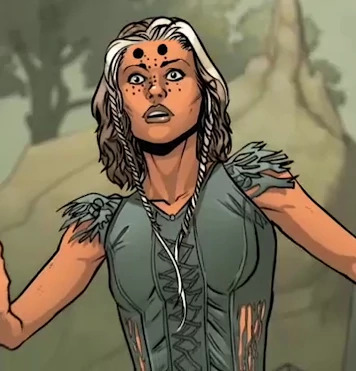
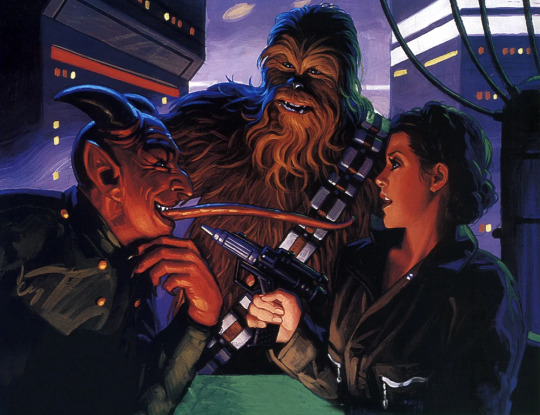
A bipedal mammalian species, Devaronians evolved in the dense jungles of Devaron as a hunter-gather species. Their bodies were denser than most humanoids' and as a result they were heavier than their appearance would tend to indicate. Devaronians had silver-based blood, which appeared thick and black when exposed. They possessed a unique blood filtration and cleansing system which processed through two livers. Because their bodies were constantly cleansed of toxins and carcinogens, the species was highly resistant to poison. To this end, sulfur was used as a stimulant on Devaron to enhance speed and strength, because inhaling it caused the substance to enter the bloodstream rapidly. Their livers struggled to eliminate sulfur from their system, meaning that long-term use could be dangerous.
The Devaronians were one of the more unusual races in the galaxy, with a dramatic gender dimorphism in appearance and temperament. The males were aggressive by nature, many being described as brash or bull-headed, with typically red-tinted skin and a pair of large horns growing from their heads. They took great pride in their horns, and groomed them quite regularly. Many species felt uncomfortable in their presence, for they resembled the devils of a thousand different myths.
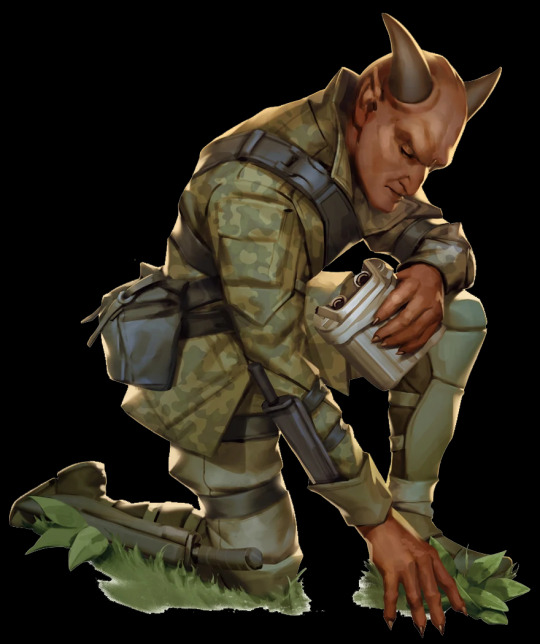
Female Devaronians were covered in thick fur that ranged in color from brown to white, hornless and had prominent canine teeth. They were docile, non-aggressive creatures. They tended to be dominant in their culture, being the only ones allowed to participate in government and politics. Several female Devaronians not covered with thick fur revealed two dark circles above the forehead, where the horns usually were in males. In addition, the teeth of the males were all sharp incisors, but the females also had molars and prominent canines. One in fifty Devaronian males had two sets of teeth, however, having an inner set of sharp "male" teeth and an outer, retractable set of "female" teeth. In primitive times, such males were used as solitary scouts by Devaronian tribes, since they could survive on either meat or plants. Males also had an extremely long tongue, though whether females shared this trait is unknown. The teeth were useful for some languages. A Devaronian had to continually and repeatedly retract and extend both sets of teeth to speak Huttese, causing aches over time.
A typical Devaronian stands at 1.7 meters or 5.6 feet tall and weighs 70 kilograms or 154 pounds.
Devaronians age at the following stages:
1 - 12 Child
13 - 17 Young Adult
18 - 44 Adult
45 - 64 Middle Age
65 - 79 Old
Examples of Names: Dmaynel Kiph, Elassar Targon, Jubal, Kapp Dendo, Tyrn Jiton, Lak Jit, Oxbel, Saricia, Sires Vant, Trynic, Ulicx Vinaq, Vilmarh Grahrk.
Languages: Devaronians speak, read, and write both Devaronese and Basic. Their speech is low, guttural, and full of snarling consonants.
22 notes
·
View notes
Text
Creating Deities and Pantheons
Creating Deities
Divine Portfolios
A deity has a certain realm that it lords over called a divine portfolio. A portfolio contains one or more species, places, things, or ideas that explain what the deity is all about. For instance, the Greek god Poseidon's divine portfolio would include the seas, storms, waterborne travel, and horses.
Minor deities will only have one item in their portfolio, but major ones could have many. Further, a major deity that wished to delegate its power, perhaps to one of its children, could bestow one of the items in its portfolio onto another deity. Perhaps one deity goes to war with another in an attempt to seize an aspect of another deity's portfolio for themselves.
New deities could even be created by filling a new role if a divine idea is not currently in any other deity's portfolio.
Generally, the more power a deity has, the more broad the aspects in their portfolio will be. Likewise, lesser deities will have more specific aspects in their portfolio. For instance, a god of nature will be more powerful than a god of trees.
When creating your own pantheon of gods, try to divide up aspects into deities' divine portfolios bearing all of this in mind.
Holy Symbol
A deity should have some sort of holy symbol that clerics can use for a spellcasting focus, but a symbol is more than that. A symbol lets mortals rally beneath it and recognize the deity's followers. It a deity's free advertisement to their people.
The symbol of a deity should reflect their portfolio in some way, as well as their alignment. It should be something unique that is easy to recognize, but also easy to replicate.
Favored Weapon
Many deities have some sort of weapon that they use and favor more than others. The deity will almost always use this weapon when manifested as an avatar. Wielding the same weapon as one's deity shows an extra step of devotion to them, even if you aren't a cleric to that god.
Random Portfolios
When creating your own deities, roll on the Random Portfolio Aspects table multiple times to find a random divine aspect to populate their portfolio. Some aspects defer you to another table to find a more specific aspect.
You can also use these tables as a jumping-off point to create your own portfolios and aspects, as there is no way to have a complete and exhaustive list.




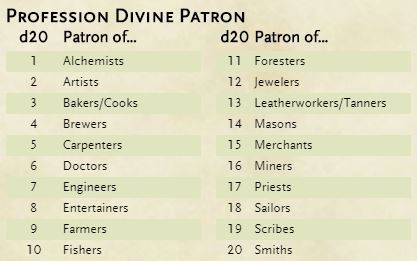

Pantheons
Pantheons are groups of deities. Your setting could have one or several pantheons. Perhaps you include pantheons from a variety of settings and incorporate them all in one place. Maybe different kingdoms or countries worship different pantheons, or just group the same deities in different ways. Our own world has many religions, each with their own god or sets of gods, so why can't your setting?
While it is possible to have a monotheistic setting where only one deity exists, polytheism tends to be more interesting and supportive. Multiple deities allow for players to choose who their character believes in. If they are a divine caster, they can choose where their powers come from. This choice affects a player's character and creates additional roleplaying opportunities as they confer with folks of the same or different religion.
Types of Pantheons
Some settings may have multiple pantheons. Here are some pantheons that can easily exist in the same setting.
Racial Pantheon. A race or species could have a whole group of gods to worship that are unique to them. For instance, the elves of your setting may worship their own set of deities. People might commonly refer to the "elf gods" or "dwarf gods" in such a circumstance.
Aspect Pantheon. A broad aspect or domain normally placed in divine portfolios may have its own pantheon. For instance, your setting may have a pantheon of death gods who take on aspects like death, undeath, afterlife, martyrdom, murder, plague, famine, and drought. All the minor aspects should be related to one greater aspect.
Regional Pantheon. In your setting, a certain region like a kingdom, country, or continent may worship different deities and have an entirely different pantheon that hold sway in their lands. Each region could have a pantheon all their own.
Religious Pantheon. Many religions exist in our own world, some of which have their own pantheons of deities. Different pantheons could have arisen in your setting from religions that developed separately. This works especially well if your deities are created through mortal belief.
Creating Pantheons
Myths. Deities in a pantheon often take on different responsibilities in running the universe, or at least take part in its history or its creation. Try to come up with myth surrounding each deity that explain why that deity exists. A deity should have some significance or importance within any pantheon you create, and your pantheon should cover a broad spectrum of created things.
Deific Relations. Deities should have complex relationships with one another to create a robust pantheon. Pick one or more from the Divine Relationships table when deciding how two deities relate, or roll randomly. Trying to justify how conflicting or unusual relationships occurred can create unique and interesting ideas. Is one deity's son also their lover? Don't be afraid to tread in the realm of mythological fantasy or dream-logic here.
Remember, existing myths are likely far stranger than anything you can come up with. A Norse cow licked a god out of primordial ice. In Greece, Athena was born of Zeus's cracked skull after he tried to eat her. The Egyptian ferry to the afterlife has a mast that is the phallus of a fertility baboon-god. So you can get pretty unusual with your myths.

Pantheon Metagame. When designing a pantheon, you should also consider satisfying different elements that exist in the game. Each player could very well worship a different deity that supports their worldview in some way.
A good start is creating gods with various alignments, not just good and evil. With nine possible alignments, you can create some interesting deities. If you are making an entirely random deity, you can roll from the Deity Alignment table to determine the deity's alignment.

Another game-related thing to consider is creating deities that will cater to existing character archetypes, such as mages, naturalists, outcasts, spiritualists, and warriors. Many pantheons have deities that would be worshiped by different classes. Try to provide deities that are tempting for each archetype to believe in, or ensure that some of your deities are more universal so many different classes would be interested in them. If you are creating a random deity, you can roll from the Archetype Patron table.
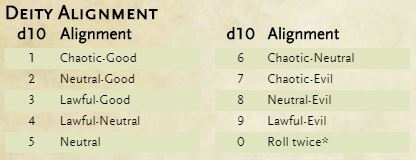
11K notes
·
View notes
Note
This is probably a very stupid question, but how did the Ancient Greeks measure time (in terms of years and months) ? What was their calendar like? What year would Alexander have viewed himself to be living in?
I love these sorts of daily-life details, so I may have got a little carried away…. Before I get into the weeds, however, I want to make everyone aware of a reference resource:
E. J. Bickerman, Chronology of the Ancient World. Thames & Hudson, 1968.
Yeah, it’s old now, but Bickerman spent most of his career on dating puzzles, and I don’t think there’s anything recent to match it. When I first was told about it years ago in my historiography class, I practically bounced off the walls. (My fellow grad students thought I’d lost my mind.)
I’m not sure of the best way to address this query—topically or geographically—but I’ll go with topically. I’ll also say upfront that I’m unfamiliar with Egypt, so they’re not much mentioned. Also, if you want more details on any particular system (Roman, Athenian, Babylonian, Jewish), there are plenty of online resources.
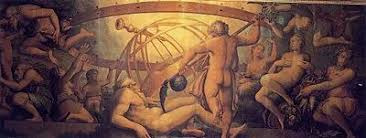
Long-count Calendar
How to number years across a span? Regnal years was most common in antiquity: year 1, year 2, year 3 of ___ king. Also, king lists detailed how long ___ ruled. The Ancient Near East (ANE) excelled at chronologies; we have some that go back to Sumer. That’s pre-Bronze Age. The span of some reigns can be deeply problematic (e.g., mythical), but we have the lists. Fun note, Neo-Assyrians named years by its major military campaign. Tells us a lot about them, no?
What about places without kings? Greece, Rome, Carthage?
The Greeks had several systems, internal and panhellenic. Internal systems often dated by the name of a prominent city magistrate. In Athens, that was the eponymous archon, in Sparta, the eponymous ephor, etc. The panhellenic system used Olympic years. In Dancing with the Lion, if you look at date plates before sections, that’s what I used. It’s a 4-year system, so, “In the year of the 97th Olympiad,” “In the first year of the 97th Olympiad,” “In the second year…,” and “In the third year…,” then we’re to “In the year of the 98th Olympiad…” In modern annotation it’s Ol. 97.1, Ol. 97.2, Ol. 97.3, Ol. 97.4. From (our year) 776 BCE down into the Roman Imperial era, the Olympics made useful anchor dating for the eastern Mediterranean (Magna Graecia).
Rome had its own system: two in fact. It counted years by both consuls, but also AUC = ab urba condita … “from the founding of the city.” Carthage used a similar system involving their two senior Judges for their senate.
When it came to “world histories,” authors such as Diodoros Siculus used several systems: Olympiad, Athenian archon, and Roman consuls. It gets a bit unwieldy, but is about as universal as we have for the Med until Christianity took over everything.
Yearly Calendars
Much of the ancient world used lunar (354 days), not solar (356 days) calendars. Yes, they knew a lunar year didn’t line up with the solar, and they used “intercalation” to fix it, avoiding summer festivals being celebrated in winter. Either a 13th month was needed every 3 years, or they added a few days to months here and there, making a “lunisolar” calendar. We have an intercalated day in our own calendar: Feb. 29th in Leap Year. To fix a calendar, however, an “anchor” is needed. This anchor is usually a solstice or equinox, which may (or may not) correspond to their New Year.
Our modern (Western) world places New Year’s in the dead of winter. But many pre-modern calendars put it in spring. Makes sense: life renews, it’s a new year. The Babylonian New Year was decided by the spring equinox—first new moon after—which pattern affected most of the ANE.
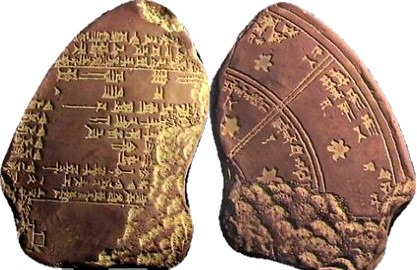
The Hebrew New Year (Rosh Hashana) is in autumn, but their first month (Nisan) is in spring. (They also have a New Year for Trees! Tú bish'vat. How cool is that?) Wanna know when your Jewish friends are having a holiday? Use Hebcal, the gold standard.

MANY ancient cultures have more than one calendar running at a time. So do we. Working in the uni, I have the “normal” year, but also the “academic” year to keep up with.
Despite the dominance of certain early systems like Babylon, counting the new year was specific to a region and people, and their religious traditions. No single Greek new year tradition existed. Both Delos and Athens used the first new moon after the summer equinox: early July. The Macedonian calendar seems to as well, so Alexander was born in the first month of the year. Other city states were different. I’ve forgotten most but do remember Sparta’s is in autumn because their new year almost falls on my birthday.
Remember, although we today talk about “ancient Greece” as if it were a country—it wasn’t. There was a landmass called Hellas, but each city-state was independent, and had its own laws, gov’t, coinage, and religious cult. Too often “Greek” winds up being conflated with “Athenian,” because we happen to have the most evidence from ancient Athens. But both Athens and Sparta were weirdos. Corinth, Thebes, Argos, Mytilene, Cos, Eretria, Miletus…all were a lot more typically Greek in their gov’t systems, etc. There were also 3 (or 4) different branches of Greek: Ionic-Attic, Doric, and Aeolic. When we talk about reading the “ancient Greek” language today, most people mean Attic Greek, or even Koine Greek (Hellenistic era common Greek).
That means every city-state had its own calendar, connected to its own festivals.
In fact, most city-states had several: sacred, civic, etc. Athens had a 12-month lunar calendar for festivals, but a 10-month civic calendar corresponding to the 10 tribes for Assembly business. Originally, they had only 4 tribes, not 10, so political changes meant calendar changes.
In each city-state, month names were derived from the major festival for that month. We have the complete month names for only a few: Athens is one and (fortunately for me) Macedon is another (specifically Ptolemaic, but it’s likely the same as the Argead). Below “Ancient Greek Month” REALLY means “Athenian month,” which annoys the hell out of those of us who don’t consider Athens the be-all and end-all of Greek history!
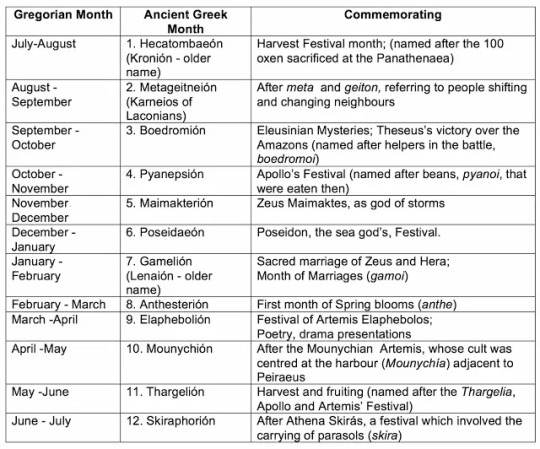
Because their months were lunar, they bisect our months, e.g., July/Aug = Athenian Hekatombian or Macedonian Loos [Alexander’s birthmonth], Jan/Feb = Athenian Gamelion or Macedonian Peritios [probably the month that gave Alexander’s favorite hound his name: Peritos]. Likewise, as the Athenian new year began in midsummer, dating ancient events also bisects. You’ll see 342/1 to designate the year from July of 342 BCE to June of 341.
As mentioned, most places used lunar months as the most basic time-keeping, but the moon isn’t the only way to make a “month.” Rome originally had 10 months of 30/31 days, adding 2 later, which is why our 12 months have Romanesque names.
Just remember: NO UNIVERSAL SYSTEM for months.
What About Weeks?
A seven-day week is borrowed from the Jews via Christianity. Both Jews and Egyptians had a dedicated day of rest. (For Egypt, the 10th day.) In most places, however, days off were festival related. Every month had festivals, which might last from half a day to several days in a row. You worked…took off for a festival…then you worked. No regular day of rest. (For the modern weekend? Thank unions and the Labor Movement!)
How did others subdivide a month? Athenian months were c. 30 days, divided into 10s: 1-10, 11-20, 10-1. Yup, the last is backwards. But dating also counted waxing and waning moons. So the new moon began a month, the 7th of the month would be the 7th waxing moon, the 24th the 6th waning moon. This is the Athenian system. Other city-states are less clear, but probably similar.
Romans had kalens (1st), nones (7th), and ides (15th). Nundinae (market days) means 9th, but were really the 8th day. The 7-day week is late Imperial and, again, owes to Christian take-over of Jewish weeks.
Most systems had “auspicious” and “inauspicious” days for religious activities, civic activities, and business activities. Don’t start anything on an inauspicious day! (These were manipulated, especially in Rome, but that’s a whole different discussion.) The closest modern equivalent I can think of is Mercury Retrograde. 😊 Although in modern Greece, signing a contract on a Tuesday morning is bad juju, or May 29th. Constantinople fell on a Tuesday morning May 29th, 1453. We might, in America, consider 9/11. Who wants to open a business on 9/11?
The Horai (The Hours)
When did the day begin? Again, the ANE and Med are different. In the ANE, day typically began at sunset. So yes, that’s why the Jewish shabbat starts at sunset on Friday and lasts till sunset on Saturday. (If you didn’t know, the Jewish “day of rest” isn’t Sunday, but Saturday.)
For Greece and Rome, et al., day began at dawn. Each day was then evenly divided between day and night, so there was no standard length of an hour. It depended on the time of year. Each half had twelve hours, subdivided into 4 groups of triads. Originally in Greece it seems there were only 9, not twelve, but they increased to match the lunar months. The division of 4 groups of triads also yielded the 4 seasons of 3 months each. Hora was initially a season, not an hour.
In any case, dawn was always the first hour, noon the 6th, sunset the 12th. Same deal for night (twilight, midnight, pre-dawn).
This is great for military and civic purposes, but most people tended to refer to daytime divisions more generally: dawn, midday, etc. And there was nothing like minutes or seconds. That’s totally modern. Closest, they might come would be to count “breaths.”
The gnomon (sundial) was the chief way to measure hours, as it matched longer or shorter days. But it’s kinda hard to use a sundial at night, or on a cloudy day, or inside. Night hours were approximate.

The water clock (klepsudra) was first popularized in Greece in courts and the Assembly (to time speeches), but spread to other use, for inside or on shady days. Yet water clocks are unwieldy to carry around.
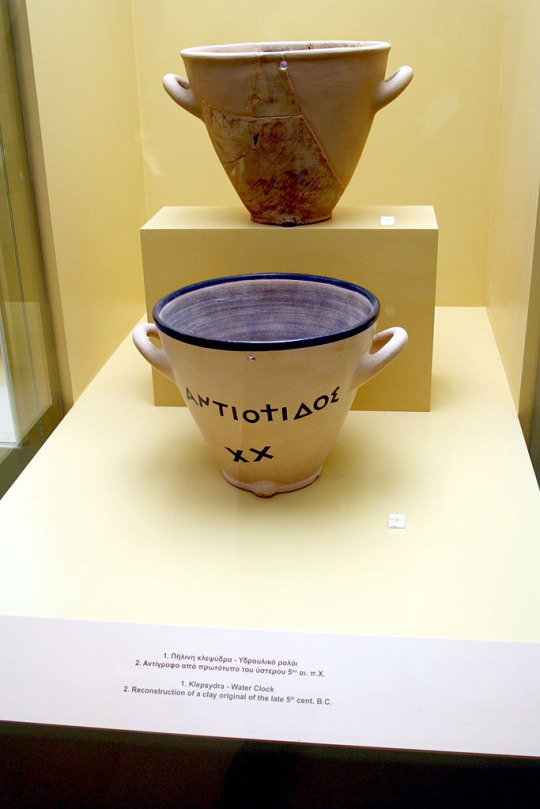
The Romans did have portable sundials (below), but again…needs the SUN. Btw, I should add that sundials aren’t only a Greco-Roman thing. The Chinese had them too. By contrast, the sand-clock or hourglass is a medieval invention. Won’t find them in the ancient world.
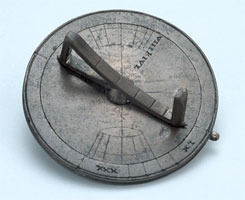
#time-keeping#calendars#time in the ancient world#months in the ancient world#ancient Greece#ancient Rome#ancient near east#Jewish calendars#sundials#the Horae#The Hours#Classics#ancient history#ancient Mediterranean history#asks
95 notes
·
View notes